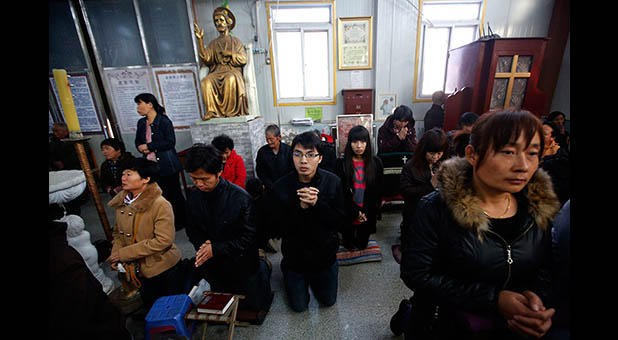Religious Persecution of Christians Has Intensified in China
A disturbing new report from Freedom House shows how widespread religious persecution is in China. Titled “The Battle for China’s Spirit,” this report looks at “religious revival, repression and resistance under [General Secretary of the Communist Party of China] XI Jinping.” The report reveals that “under Xi Jinping’s leadership, religious persecution in China has increased overall.” Despite this intensification of persecution, the Chinese religious have remained resilient. “Religion and spirituality have been deeply embedded in Chinese culture and identity for millennia,” notes the report’s author, Sarah Cook, in its executive summary. “This fact posed a challenge for the avowedly atheist Chinese Communist Party (CCP) when it came to power in 1949, and its strategies for dealing with religiosity in Chinese society have fluctuated in the decades since.”
The report looks at the millions of believers in China, focusing on China’s recognized religions: Buddhism, Catholicism, Christian sects, Islam, Protestantism, Taoism and “new religious movements.” The crackdown on religion from the CCP has led to a cycle of revival, repression and resistance:
Since Xi Jinping took the helm of the Chinese Communist Party (CCP) in November 2012, the authorities have intensified many of their restrictions, resulting in an overall increase in religious persecution. But believers have responded with a surprising degree of resistance, including in faith communities that have generally enjoyed cooperative relationships with state and party officials.
This escalating cycle of repression and pushback illustrates a fundamental failure of the Chinese authorities’ religious policies. Rather than checking religion’s natural expansion and keeping it under political control, the CCP’s rigid constraints have essentially created an enormous black market, forcing many believers to operate outside the law and to view the regime as unreasonable, unjust or illegitimate.
The report summarizes four core components of the Chinese Communist Party’s religious policy:
- Opportunistic exploitation: Harnessing the benefits of religion to advance broader CCP economic, political, cultural and foreign policy goals
- Rule by law: Developing legal and bureaucratic instruments to control religious practice and institutions
- Selective eradication: Fiercely suppressing religious groups, beliefs and individuals deemed to threaten party rule or policy priorities, often via extralegal means
- Long-term asphyxiation: Adopting measures to curb religion’s expansion and accelerate its extinction among future generations
The executive summary included anecdotal stories of oppression:
A Taoist disciple joins the order without knowing when he will be admitted to priesthood. Dozens of Christians are barred from celebrating Christmas together. Tibetan monks are forced to learn reinterpretations of Buddhist doctrine during a “patriotic reeducation” session. A Uighur Muslim farmer is sentenced to nine years in prison for praying in a field. And a 45-year-old father in northeastern China dies in custody days after being detained for practicing Falun Gong.
The intensity of the persecution is not the same for everyone. The involvement of the government depends on the location, ethnicity and religion of the individual. Many religious people were found to experience no difficulty practicing their faiths. Taoists were the lowest on the “spectrum of religious persecution,” while Muslims and Tibetan Buddhists were among the “very high.” Catholics and Protestants were moderate and high, respectively. In some cases, government “authorities even offer[ed] active support for certain activities.” Others, however, experienced serious persecution, both nonviolent and violent:
Chinese officials have banned holiday celebrations, desecrated places of worship and employed lethal violence. Security forces across the country detain, torture or kill believers from various faiths on a daily basis. How a group or individual is treated depends in large part on the level of perceived threat or benefit to party interests, as well as the discretion of local officials.
Nonviolent forms of control are more prevalent, but they are also deeply offensive to many believers, directly intruding on the internal functions of religious organizations. They include vetting religious leaders for political reliability, placing limits on the number of new monastics or priests and manipulating religious doctrine according to party priorities. Extensive surveillance, “reeducation” campaigns and restrictions on private worship affect the spiritual lives of millions of people. And increasingly, economic reprisals and exploitation have become a source of tension and a catalyst for protests.
From November 2012 to November 2016, several groups have faced increased persecution, including Protestants:
Since early 2014, local authorities have intensified efforts to stem the spread of Christianity amid official rhetoric about the threat of “Western” values and the need to “Sinicize” religions. As the larger of the two main Christian denominations in China, Protestants have been particularly affected by cross-removal and church-demolition campaigns, punishment of state-sanctioned leaders, and the arrest of human rights lawyers who take up Christians’ cases.
Uighur and Hui Muslims and Tibetan Buddhists also faced increased persecution during the timeline. Roman Catholics actually faced less persecution. While some churches were forced to remove crosses, the relationship between Beijing and the Vatican seems to be growing friendlier.
The horrors of religious persecution are not limited to “religious life.” There are terrible political, economic and social implications:
The human cost of the CCP’s controls and abuses is overwhelming. Religious prisoners form the largest contingent of prisoners of conscience in China. With each passing day, more Chinese citizens are swept into the party-state’s repressive apparatus for engaging in peaceful spiritual practice. Families are torn apart, injuries and psychological damage are inflicted and lives are lost. In some parts of the country—like Xinjiang, Zhejiang and Heilongjiang, for example—high levels of persecution cut across multiple groups, with police officers and judges potentially being asked to target members of several faiths. [Emphasis added]
China was also called out in Freedom House’s recent “Freedom in the World” Report. Rated “Not free,” China received a downward-trend arrow thanks to the Chinese Communist Party’s increased control over the media, religious groups and civil associations. {eoa}
This article was originally published at Acton.org. Used with permission.














































